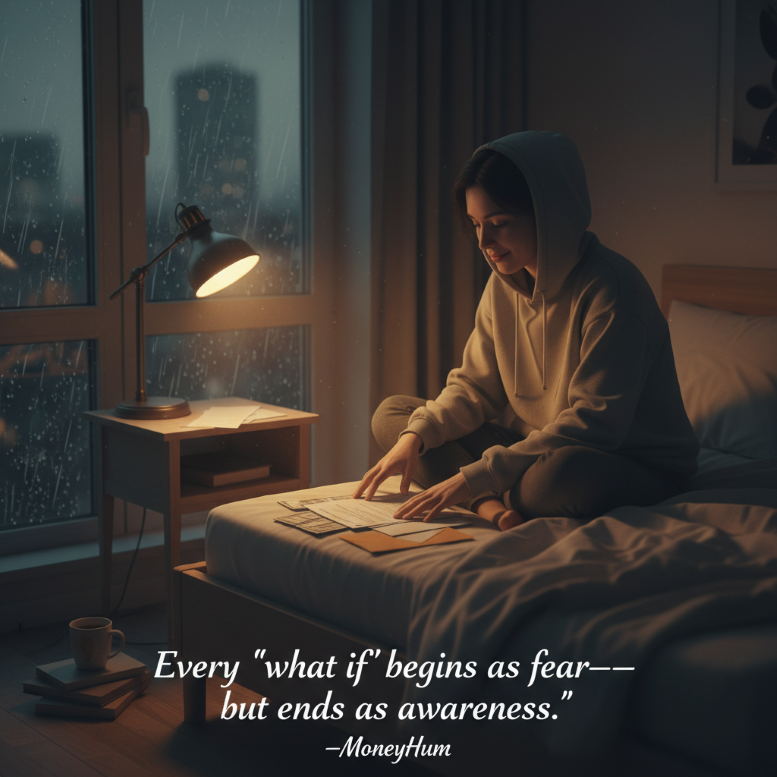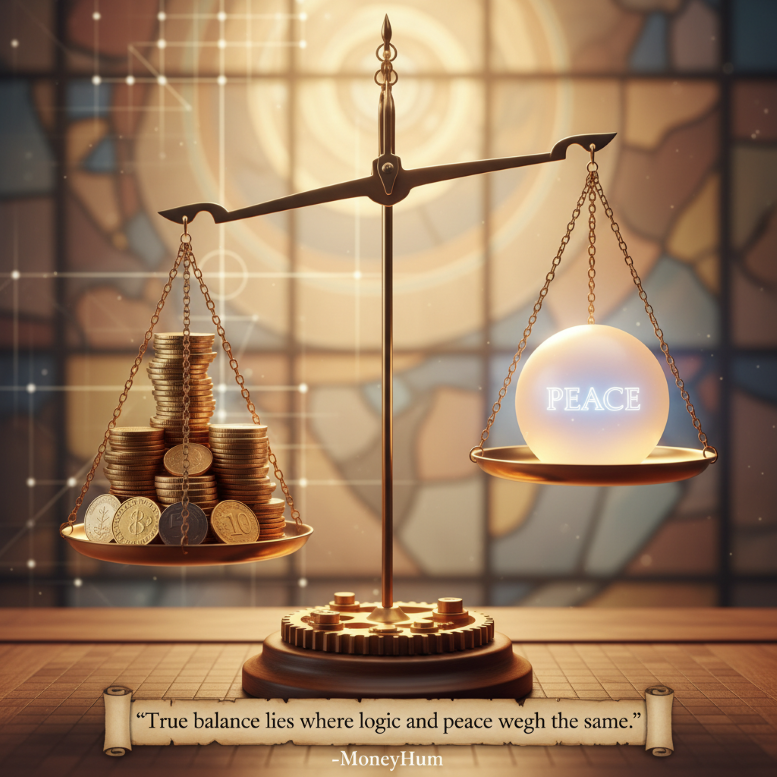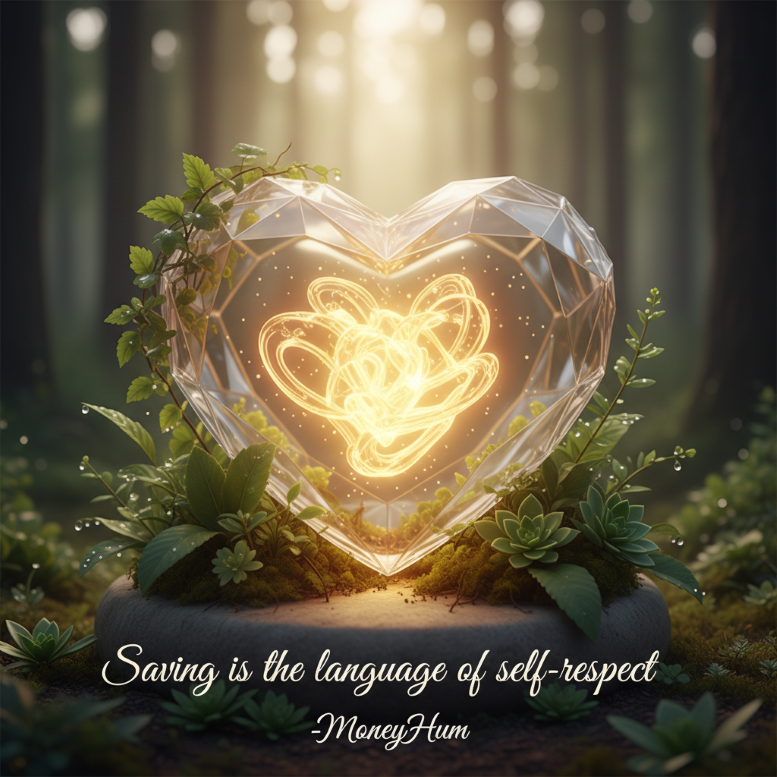A Journey Through Calm Preparedness and Financial Self Trust
Chapter I
The Quiet Fear Beneath “What If”
There’s a subtle moment that visits most of us:
when the car makes a strange sound on the highway,
or the manager announces an unexpected restructuring,
or a medical bill arrives that we weren’t ready for.
In that moment, the mind doesn’t immediately think of numbers.
It thinks of control or the loss of it.
That quiet fear beneath the question “What if something happens?” is not about money at all.
It’s about safety.
It’s about whether life will still be okay when uncertainty knocks.

Most people think of an emergency fund as a financial concept.
But at its core, it is a psychological cushion a silent contract with yourself that says:
“Even if life surprises me, I will not crumble. I’ll have space to breathe before I act.”
And that space, that pause, changes everything.
The human brain doesn’t like unpredictability.
Evolution built it for survival, not serenity.
When faced with uncertainty, the amygdala (the emotional alarm center) lights up, flooding us with anxiety signals.
In prehistoric times, that meant scanning for predators.
Today, it means scanning for unpaid bills.
Money worries activate the same neural pathways as physical danger.
You’re not “overreacting” when financial uncertainty makes you anxious.
You’re being human.
But here’s the paradox:
Even though uncertainty frightens us, we still resist preparing for it.
We tell ourselves:
- “I’ll save when I earn more.”
- “I’ll handle it when it happens.”
- “It’s not urgent.”
That avoidance isn’t laziness it’s a form of emotional self protection.
It’s hard to confront the idea that something bad might happen.
So we postpone it, thinking that by ignoring the possibility, we reduce the pain.
But we don’t.
We just delay it and compound it with interest.
Read next: Financial Anxiety Is the Modern Disease: How to Heal Money Fear & Stress
Chapter II
Why Our Minds Resist Saving for Emergencies
To truly understand the emergency fund, we must first understand the enemy: our own psychology.
Behavioral economists like Daniel Kahneman and Richard Thaler have shown that we rarely make financial decisions logically.
We make them emotionally then justify them rationally.
Here are the psychological patterns that silently sabotage our emergency fund:

1. Optimism Bias
We believe bad things happen to others.
We underestimate how likely we are to face a job loss, illness, or sudden expense.
Optimism bias is comforting in the short term it reduces anxiety
but dangerous in the long term because it prevents preparation.
The irony? People who plan for bad days worry less, not more.
Because planning doesn’t increase fear it transforms it into calm readiness.
2. Present Bias
We prioritize the present over the future a well documented human flaw.
We choose the new phone today instead of saving for the crisis that might come tomorrow.
It’s not because we’re impulsive or irresponsible.
It’s because the brain’s reward system favors immediate gratification.
When you save for an emergency, you’re essentially rewarding your future self.
But that self feels distant, almost imaginary.
The key, then, is to bring the future self closer to feel emotionally connected to the version of you who will thank you later.
Ask yourself:
“If I lost my job next month, what would I want to have already done for myself?”
That question builds empathy across time.
3. Loss Aversion
People feel the pain of losing ₹1,000 almost twice as strongly as the pleasure of gaining it.
So when we move money from a savings account into an “untouchable” emergency fund, it feels like losing spending power even though it’s not gone.
Loss aversion tricks the brain into equating saving with sacrifice.
But saving is not losing.
It’s transferring your peace of mind from the future into the present.
4. Denial and Decision Fatigue
Financial planning requires confronting uncomfortable truths debt, dependence, or fragile job security.
The brain, already burdened by daily decisions, resists another emotionally heavy choice.
So it pushes the thought away.
Creating an emergency fund, therefore, is not just a budgeting exercise
it’s an act of courage.
It means facing life’s uncertainty with open eyes and saying, “I trust myself enough to prepare.”
5. The Illusion of Control
We like to believe we can prevent emergencies by being careful driving safely, working hard, eating right.
But life doesn’t negotiate.
Preparation doesn’t prevent the storm; it builds the shelter.
That’s what an emergency fund is a psychological shelter.
And the moment you build it, something shifts inside.
You stop reacting to life in panic.
You start responding to it with presence.
Explore more: Why You Keep Chasing Quick Profits
Chapter III
The Mathematics of Security
Let’s move from emotion to logic
because peace of mind must rest on numbers as well as philosophy.
The emergency fund is the mathematical expression of emotional stability.
It translates uncertainty into a clear, quantifiable buffer.
But the question that confuses most people is simple:
How much do I really need?
You’ve probably heard the textbook answer:
“3 to 6 months of expenses.”
But that’s an oversimplification.
Let’s make it personal, realistic, and mathematically grounded.
Step 1: Identify Your Core Monthly Expenses
Start by calculating what you actually need to survive not live luxuriously, but sustain your life comfortably.
That includes:
- Rent or home EMI
- Groceries and utilities
- Insurance premiums
- Minimum loan EMIs
- Healthcare essentials
- Transportation
- Basic communication (phone/internet)
Ignore vacations, shopping, dining out, or new gadgets.
Your emergency fund exists for survival, not indulgence.
Let’s call this number your Core Expense (CE).
Step 2: Multiply by Your Stability Factor
Now comes the emotional logic behind the math.
The right size of your emergency fund depends on how stable your income and life situation are.

| Stability Level | Description | Recommended Fund |
|---|---|---|
| High Stability | Government job, dual income household, low debt | 3 months of CE |
| Medium Stability | Private sector job, manageable debt, no dependents | 4–6 months of CE |
| Low Stability | Self employed, single income, variable cash flow, dependents | 6–9 months of CE |
| Unstable/High Risk | Freelancer, startup founder, high medical dependency | 9–12 months of CE |
This framework personalizes your fund making it emotionally aligned with your lifestyle rather than arbitrary.
Step 3: Account for Inflation and Unpredictables
Prices rise, and crises rarely come neatly packaged.
Add a 10–15% safety margin to your calculation.
That buffer is not excess it’s wisdom.
Example Calculation
Let’s take Aisha, a 29-year-old marketing executive.
- Core monthly expenses: ₹45,000
- Stability factor: Medium (private sector job) → 6 months
- Emergency fund target = ₹45,000 × 6 = ₹2.7 lakh
- Add 10% buffer → ₹2.97 lakh
Her ideal emergency fund = ₹3 lakh
This number is not random it’s psychological clarity written in digits.
Step 4: Break It into Stages
Building ₹3 lakh may feel intimidating.
But like all powerful things, it grows one quiet step at a time.
Think of it in three levels:
- Starter Fund → ₹25,000–₹50,000 (for small shocks)
- Core Fund → 3 months of expenses
- Complete Fund → 6–12 months
Each milestone brings a deeper sense of calm and a quieter mind.
The beauty of this system is not in perfection, but progress.
Even a small emergency fund changes your emotional relationship with money.
You stop viewing every expense as a threat.
You start viewing money as a companion one that helps you stand taller.
Continue reading: Your Financial System Needs a Dashboard — Not Just Dreams
Chapter IV
The Architecture of Calm — Where to Keep Your Fund

An emergency fund is not just about how much you have it’s about how available and protected it is.
Many people make the mistake of either:
- Keeping all their emergency money in their main savings account (too easy to spend), or
- Locking it entirely in fixed deposits or investments (too hard to access when truly needed).
True mastery lies in designing your fund like a layered safety net each layer serving a purpose, balancing liquidity, safety, and growth.
Let’s call this the Three Tier Architecture of Calm.
Tier 1: Immediate Access (Liquid Safety)
Purpose: Instant availability for emergencies that can’t wait medical needs, car repairs, etc.
Where to keep it:
- High interest savings account or
- Sweep in FD (an FD linked to your savings account for automatic liquidity).
Ideal Allocation: 20–30% of your total emergency fund.
Example:
If your fund is ₹3 lakh, keep ₹60,000–₹90,000 in a high interest savings account.
Goal: You should be able to access this money within minutes, without worrying about penalties or paperwork.
This is your psychological oxygen.
Tier 2: Near Term Stability (Liquid Mutual Funds or Short FDs)
Purpose: Funds you might need within a few days to a week.
Where to keep it:
- Liquid mutual funds (which invest in ultra short term instruments with minimal risk), or
- Short term FDs (1–3 months).
Ideal Allocation: 40–50% of your total emergency fund.
These funds earn slightly better returns than a savings account, without compromising safety.
Withdrawal from most liquid funds takes T+1 day (the next business day).
This middle tier balances accessibility and return.
It’s your “calm zone” money that quietly grows while still standing guard.
Tier 3: Extended Security (Short Term Debt or Conservative Hybrid Funds)
Purpose: Funds for longer disruptions job loss, major repairs, family medical needs.
Where to keep it:
- Short term debt mutual funds
- Low risk conservative hybrid funds
- FDs with 6–12 month tenure
Ideal Allocation: 20–30% of your total emergency fund.
These instruments offer stability with slightly better returns (5–7% range).
They may take a few days to liquidate but that’s acceptable since these are for prolonged situations.
When you structure your emergency fund this way, you’re not just “saving money.”
You’re building a financial nervous system responsive, balanced, and alive.
You’ll sleep better knowing that your safety isn’t buried in complexity or lost to temptation.
It’s quietly breathing alongside you accessible, efficient, and patient.
Chapter V
Building It Brick by Brick
Understanding is easy.
Consistency is hard.
And the hardest part of building an emergency fund isn’t the math it’s the emotional endurance of doing something that doesn’t give instant gratification.
This chapter isn’t about theory. It’s about how to make it happen quietly, steadily, realistically.

Step 1: Automate the Habit
Willpower is overrated. Systems are stronger.
Set up a monthly auto transfer from your salary account to a separate “Emergency Fund” account even if it’s just ₹2,000 or ₹5,000.
Think of it as a monthly gift to your future self.
You’re not depriving yourself; you’re protecting the person you’ll become.
Automation bypasses emotional friction you don’t have to “decide” each month; it just happens.
See: Build a Strong SIP Habit: Your Simple 12-Month Plan for Beginners
Step 2: Create a Visual Tracker
What we can see, we care about.
Track your progress with a simple spreadsheet, app, or notebook.
Celebrate milestones ₹10,000, ₹25,000, ₹50,000, ₹1 lakh not with shopping, but with acknowledgment.
Each milestone isn’t just money accumulated it’s anxiety reduced.
Progress feels abstract until you visualize it.
So give it shape, color, and emotion.
Step 3: Protect It from Emotional Spending
Here’s the hardest truth:
Most emergency funds are not destroyed by emergencies.
They’re destroyed by rationalizations.
- “It’s a one time expense.”
- “I’ll replace it next month.”
- “I deserve this after such a long week.”
These aren’t financial mistakes they’re emotional leaks.
To prevent them, you must separate intention from temptation.
Practical tip:
Use a different bank for your emergency fund.
Don’t link it to UPI.
Make access slightly inconvenient enough to create a pause.
That pause is your defense mechanism.
Read: Emotional Spending Psychology: Why We Buy What We Don’t Need (And How to Stop)
Step 4: Refill After Use
Life will test your preparedness and that’s okay.
The purpose of an emergency fund is to be used when needed, not hoarded forever.
But once used, it must be rebuilt as a priority.
Think of it like your body healing after an injury restock the cells, strengthen the structure, return to balance.
Each refill is a reaffirmation of trust in yourself.
Step 5: Keep It Dynamic
Your life changes.
Your emergency fund should too.
Review it every year after a job change, marriage, home purchase, or child’s birth.
Update your Core Expense and Stability Factor.
Your fund is not static; it evolves with your life’s rhythm.
Let it grow with compassion and intelligence not fear.
Read next: The Hidden Cost of Constant Hustle: Why Doing Less Earns More
Chapter VI
Peace Over Perfection
Here’s a truth most financial guides don’t tell you:
Your emergency fund will never feel “enough.”
No matter how much you save, uncertainty will always whisper, “What if it’s not sufficient?”
That whisper is not a signal to save endlessly it’s a reminder to trust your own resilience.
Because money doesn’t remove uncertainty.
It just gives you the time and mental clarity to navigate it.
The real strength of an emergency fund lies not in the number it represents, but in the emotional shift it creates:
From panic → to pause
From reaction → to response
From chaos → to calm

The Paradox of Preparedness
People often ask,
“Isn’t keeping too much cash wasteful when it could be invested?”
It’s a fair question.
But the answer depends on what kind of wealth you’re measuring.
Financial wealth compounds over years.
Emotional wealth compounds every night you sleep peacefully.
You can’t optimize everything.
Sometimes, the best ROI is peace.
That’s why the emergency fund is not a “low return asset.”
It’s a high clarity asset.
It buys you the ability to make thoughtful decisions instead of impulsive ones the difference between survival and stability.
Also read: The Path to Real Wealth: Why Patience and Compounding Beat Shortcuts
The Emotional Math of Calm
Think of your emergency fund as emotional arithmetic:
- ₹10,000 = The ability to face a flat tire calmly.
- ₹50,000 = The power to say no to a toxic client.
- ₹2 lakh = The space to choose rest over panic after job loss.
- ₹5 lakh = The quiet confidence that you can handle almost anything.
This is not about ego.
It’s about equilibrium.
When you stop fearing emergencies, you start living more freely.
You take smarter risks, dream bigger, and stop clinging to scarcity.
Because security gives birth to creativity.
And that, in truth, is the invisible compounding of emotional wealth.
Epilogue: Your Financial Safety as Self Love
If there’s one message to take away from this journey, it’s this:
“An emergency fund is not about expecting disaster it’s about respecting life.”
We prepare not because we expect chaos,
but because we value peace.
When you create an emergency fund, you’re telling yourself:
“I matter enough to protect.”
It’s self respect in financial form.
It’s compassion that compounds.
Because the moment you have a cushion, you stop making decisions from fear and start making them from freedom.

The Quiet Power of Readiness
Readiness doesn’t mean paranoia.
It means alignment.
It’s the art of being strong and soft at once.
And that balance between saving and living, between logic and emotion is where real financial maturity begins.
Closing Reflection
You don’t build an emergency fund just for emergencies.
You build it for life’s unpredictability, for mental stillness, for emotional bandwidth.
You build it so that when the next “what if” arises, your heart can whisper back:
“Whatever happens, I’ll be okay.”
Key Takeaways — The Calm Framework
- Safety is psychological before it’s financial. An emergency fund is a peace fund a boundary against panic.
- Personalize your number. Use the 3–12 month rule based on stability, not arbitrary formulas.
- Structure your fund across layers. Keep liquidity, safety, and returns balanced through a 3 tier approach.
- Automate and protect it. Systems beat willpower. Barriers beat temptation.
- Revisit and rebuild. Let your fund evolve with your life it’s a living reflection of your self trust.
If you’ve read this till the end, thank you❤️
With love,
Your Dearest Friend,
Chitraansh
To Continue Your Journey
If this piece helped you feel calmer about money, you might also find resonance in these:







